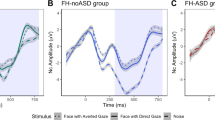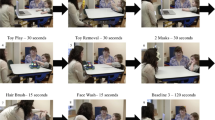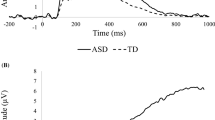Abstract
Few behavioral indices of risk for autism spectrum disorders (ASD) are present before 12 months, and potential biomarkers remain largely unexamined. This prospective study of infant siblings of children with ASD (n = 16) and low-risk comparison infants (n = 15) examined group differences in event-related potentials (ERPs) indexing processing of facial positive affect (N290/P400, Nc) at 9 months and their relation to joint attention at 15 months. Group differences were most pronounced for subtle facial expressions, in that the low-risk group exhibited relatively longer processing (P400 latency) and greater attention resource allocation (Nc amplitude). Exploratory analyses found associations between ERP responses and later joint attention, suggesting that attention to positive affect cues may support the development of other social competencies.





Similar content being viewed by others
Notes
Consistency in the recruitment procedures and inclusion/exclusion criteria as well as in data acquisition procedures was ensured by joint in-person training on all study procedures for the research staff at the three sites. Standardized behavioral assessments at each site were administered by trained clinical psychologists, ensuring strict adherence to the established procedural guidelines. All EEG data were processed and analyzed by the single lab, ensuring consistency in artifact detection procedures.
References
American Psychiatric Association. (2000). Diagnostic and statistical manual of mental disorders-IV-text revision. Washington, DC: Author.
Berument, S., Rutter, M., Lord, C., Pickles, A., & Bailey, A. (1999). Autism screening questionnaire: Diagnostic validity. The British Journal of Psychiatry, 175, 444–451.
Boccia, M., & Campos, J. J. (1989). Maternal emotional signals, social referencing, and infants’ reactions to strangers. New Directions for Child Development, 44, 25–49.
Bolton, P., Macdonald, H., Pickles, A., Rios, P., Goode, S., Crowson, M., et al. (1994). A case–control family history study of autism. Journal of Child Psychology and Psychiatry, 35, 877–900.
Campos, J., & Stenberg, C. (1981). Perception, appraisal and emotion: The onset of social referencing. In M. E. Lamb & L. R. Sherrod (Eds.), Infant social cognition. Hillsdale, NJ: Erlbaum.
Centers for Disease Control and Prevention. (2014). Autism. http://www.cdc.gov/ncbddd/autism/addm.html.
Chevallier, C., Kohls, G., Troiani, V., Brodkin, E. S., & Schultz, R. T. (2012). The social motivation theory of autism. Trends in Cognitive Sciences, 16(4), 231–239.
Csibra, G., Kushnerenko, E., & Grossmann, T. (2008). Electrophysiological methods in studying infant cognitive development. In C.A. Nelson & M. Luciana (Eds.), Handbook of Developmental Cognitive Neuroscience (2nd ed., pp. 247–262). MIT Press.
Dawson, G., Jones, E. J. H., Merkle, K., Venema, K., Lowy, R., Faja, S., et al. (2012). Early behavioral intervention is associated with normalized brain activity in young children with autism. Journal of the American Academy of Child and Adolescent Psychiatry, 51(11), 1150–1159. doi:10.1016/j.jaac.2012.08.018.
Dawson, G., Toth, K., Abbott, R., Osterling, J., Munson, J., Estes, A., et al. (2004). Early social attention impairments in autism: Social orienting, joint attention, and attention to distress. Developmental Psychology, 40, 271–283.
Dawson, G., Webb, S. J., Wijsman, E., Schellenberg, G., Estes, A., Munson, J., et al. (2005). Neurocognitive and electrophysiological evidence of altered face processing in parents of children with autism: implications for a model of abnormal development of social brain circuitry in autism. Development and Psychopathology, 17(3), 679–697. doi:10.1017/S0954579405050327.
de Haan, M., Belsky, J., Reid, V., Volein, A., & Johnson, M. H. (2004). Maternal personality and infants’ neural and visual responsivity to facial expressions of emotion. Journal of Child Psychology and Psychiatry, 45, 1209–1218.
de Haan, M., Johnson, M. H., & Halit, H. (2003). Development of face-sensitive event-related potentials during infancy: A review. International Journal of Psychophysiology, 51(1), 45–58.
de Haan, M., & Nelson, C. A. (1997). Recognition of the mother’s face by six-month-old infants: A neurobehavioral study. Child Development, 68(2), 187–210.
de Haan, M., & Nelson, C. A. (1999). Brain activity differentiates face and object processing in 6-month-old infants. Developmental Psychology, 35(4), 1113–1121.
Dereu, M., Roeyers, H., & Raymaekers, R. (2012). Exploring individual trajectories of social communicative development in toddlers at risk for autism spectrum disorders. Research in Autism Spectrum Disorders, 6(3), 1038–1052.
Eimer, M., & Holmes, A. (2002). An ERP study on the time course of emotional face processing. NeuroReport, 13(4), 427–431.
Elsabbagh, M., Volein, A., Csibra, G., Holmboe, K., Garwood, H., Tucker, L., et al. (2009). Neural correlates of eye gaze processing in the infant broader autism phenotype. Biological Psychiatry, 65(1), 31–38. doi:10.1016/j.biopsych.2008.09.034.
Georgiades, S., Szatmari, P., Zwaigenbaum, L., Bryson, S., Brian, J., Roberts, W., Smith, I., et al. (2012). A prospective study of autistic-like traits in unaffected siblings of probands with autism spectrum disorder. Archives of General Psychiatry, E1–E7. doi:10.1001/2013.jamapsychiatry.1.
Halit, H., de Haan, M., & Johnson, M. H. (2003). Cortical specialization for face processing: Face-sensitive event-related potential components in 3- and 12-month-old infants. Neuroimage, 19(3), 1180–1193.
Hornik, R., & Gunnar, M. R. (1988). A descriptive analysis of infant social referencing. Child Development, 59, 626–634.
Ibanez, L. V., Grantz, C. J., & Messinger, D. S. (2013). The development of referential communication and autism symptomatology in high-risk infants. Infancy, 18(5), 687–707.
Key, A., & Stone, W. (2012a). Processing of novel and familiar faces in infants at average and high risk for autism. Developmental Cognitive Neuroscience, 2, 244–255.
Key, A., & Stone, W. (2012b). Same but different: Nine-month-old infants at low and high risk for autism look at the same facial features but process them using different brain mechanisms. Autism Research, 5, 253–266.
Key, A., Stone, W., & Williams, S. (2009). What do infants see in faces? ERP evidence of different roles of eyes and mouth for face perception in 9-month-old infants. Infant and Child Development, 18, 149–162.
Landa, R., & Garrett-Mayer, E. (2006). Development in infants with autism spectrum disorders: a prospective study. Journal of Child Psychology and Psychiatry, 47(6), 629–638. doi:10.1111/j.1469-7610.2006.01531.x.
Leppänen, J., Moulson, M., Vogel-Farley, V., & Nelson, C. (2007). An ERP study of emotional face processing in the adult and infant brain. Child Development, 78(1), 232–245.
Lord, C., Risi, S., Lambrecht, L., Cook, E. H, Jr, Leventhal, B. L., DiLavore, P. C., et al. (2000). The Autism Diagnostic Observation Schedule-Generic: A standard measure of social and communication deficits associated with the spectrum of autism. Journal of Autism and Developmental Disorders, 30, 205–223.
Luyster, R., Wagner, J., Vogel-Farley, V., Tager-Flusberg, H., & Nelson, C. (2011). Neural correlates of familiar and unfamiliar face processing in infants at risk for autism spectrum disorders. Brain Topography,. doi:10.1007/s10548-011-0176-z.
McCleery, J., Akshoomoff, N., Dobkins, K., & Carver, L. (2009). Atypical face versus object processing and hemispheric asymmetries in 10-month-old infants at risk for autism. Biological Psychiatry, 66, 950–957.
Messinger, D., Young, G. S., Ozonoff, S., Dobkins, K., Carter, A., Zwaigenbaum, L., et al. (2013). Beyond ASD: A Baby Siblings Research Consortium study of high-risk siblings at three years of age. Journal of the American Academy of Child and Adolescent Psychiatry, 52, 300–308.
Mundy, P., Fox, N., & Card, J. (2003). EEG coherence, joint attention and language development in the second year. Developmental Science, 6, 48–54.
Mundy, P. C., Henderson, H. A., Inge, A. P., & Coman, D. C. (2007). The modifier model of autism and social development in higher functioning children with autism. Research and Practice for Persons with Severe Disabilities, 32, 124–139.
Mundy, P., & Sigman, M. (2006). Joint attention, social competence, and developmental psychopathology. In Mundy, P., & Sigman, M. (Eds.), Developmental psychopathology, Vol 1: Theory and method (2nd ed., pp. 293–332). Hoboken, NJ, US: Wiley.
Nelson, C. A., & de Haan, M. (1996). Neural correlates of infants’ visual responsiveness to facial expressions of emotion. Developmental Psychobiology, 29, 577–595.
Osterling, J., & Dawson, G. (1994). Early recognition of children with autism: A study of first birthday home videotapes. Journal of Autism and Developmental Disorders, 24(3), 247–257.
Ozonoff, S., Young, G. S., Carter, A., Messinger, D., Yirmiya, N., Zwaigenbaum, L., et al. (2011). Recurrence risk for autism spectrum disorders: A baby siblings research consortium study. Pediatrics, 128(3), 488–495.
Pelphrey, K. A., Shultz, S., Hudac, C. M., & Vander Wyk, B. C. (2011). Constraining heterogeneity: The social brain and its development in autism spectrum disorder. Journal of Child Psychology and Psychiatry and Allied Disciplines, 52(6), 631–644. doi:10.1111/j.1469-7610.2010.02349.x.
Presmanes, A. G., Walden, T. A., Stone, W. L., & Yoder, P. J. (2007). Effects of different attentional cues on responding to joint attention in younger siblings of children with autism spectrum disorders. Journal of Autism and Developmental Disorders, 37(1), 133–144.
Reynolds, G., & Richards, J. (2005). Familiarization, attention, and recognition memory in infancy: An event-related potential and cortical source localization study. Developmental Psychology, 41(4), 598–615.
Rosen, W. D., Adamson, L. B., & Bakeman, R. (1992). An experimental investigation of infant social referencing: Mother’s messages and gender differences. Developmental Psychology, 28, 1172–1178.
Rozga, A., Hutman, T., Young, G. S., Rogers, S. J., Ozonoff, S., Dapretto, M., et al. (2011). Behavioral profiles of affected and unaffected siblings of children with autism: Contribution of measures of mother–infant interaction and nonverbal communication. Journal of Autism and Developmental Disorders, 41(3), 287–301.
Rutter, M., Le Couteur, A., & Lord, C. (2003). Autism diagnostic interview-revised (ADI–R) manual. Los Angeles: Western Psychological Services.
Scott, L., & Nelson, C. (2006). Featural and configural face processing in adults and infants: A behavioral and electrophysiological investigation. Perception, 35, 1107–1128.
Sepeta, L., Tsuchiya, N., Davies, M. S., Sigman, M., Bookheimer, S. Y., & Dapretto, M. (2012). Abnormal social reward processing in autism as indexed by pupillary responses to happy faces. Journal of Neurodevelopmental Disorders, 4, 17.
Stone, W. L., McMahon, C. R., Yoder, P. J., & Walden, T. A. (2007). Early social communicative and cognitive development of younger sibling of children with autism spectrum disorders. Archive of Pediatrics and Adolescent Medicine, 161, 384–390.
Tabachnick, B. G., Fidell, L. S., & Osterlind, S. J. (2001). Using multivariate statistics. Allyn and Bacon.
Thomas, D., Grice, J., Najm-Briscoe, R., & Miller, J. (2004). The influence of unequal numbers of trials on comparisons of average event-related potentials. Developmental Neuropsychology, 26, 753–774.
Tierney, A. L., Gabard-Durnam, L., Vogel-Farley, V., Tager-Flusberg, H., & Nelson, C. A. (2012). Developmental trajectories of resting EEG power: An endophenotype of autism spectrum disorder. PLoS One, 7(6), e39127. doi:10.1371/journal.pone.0039127.
Tomasello, M. (1992). The social bases of language acquisition. Social Development, 1, 67–87.
Trevarthen, C., & Hubley, P. (1978). Secondary intersubjectivity: confidence, confiding and acts of meaning in the first year. In A. Lock (Ed.), Action, gesture and symbol: The emergence of language. New York and London: Academic Press.
Wetherby, A. M., Woods, J., Allen, L., Cleary, J., Dickinson, H., & Lord, C. (2004). Early indicators of autism spectrum disorders in the second year of life. Journal of Autism and Development Disorders, 34(5), 473–493.
Wong, N., Beidel, D. C., Sarver, D. E., & Sims, V. (2012). Facial emotion recognition in children with high functioning autism and children with social phobia. Child Psychiatry and Human Development, 43(5), 775–794. doi:10.1007/s10578-012-0296-z.
Yirmiya, N., Gamliel, I., Pilowsky, T., Feldman, R., Baron Cohen, S., & Sigman, M. (2006). The development of siblings of children with autism at 4 and 14 months: Social engagement, communication, and cognition. Journal of Child Psychology and Psychiatry, 47(5), 511–523.
Zwaigenbaum, L., Bryson, S., Rogers, T., Roberts, W., Brian, J., & Szatmari, P. (2005). Behavioral manifestations of autism in the first year of life. International Journal of Developmental Neuroscience, 23(2–3), 143–152.
Acknowledgments
This research was supported by National Institute of Child Health and Human Development Grant R01 HD057284 to Wendy L. Stone and Daniel S. Messinger. We would like to thank the participants and their families for their support of the study. We are grateful to Amber Vinson, Dorita Jones, Michelle Fong, Kim Ono, Devon Gangi, and Nicole Coman for their help with acquisition and processing of the ERP data.
Author information
Authors and Affiliations
Corresponding author
Rights and permissions
About this article
Cite this article
Key, A.P., Ibanez, L.V., Henderson, H.A. et al. Positive Affect Processing and Joint Attention in Infants at High Risk for Autism: An Exploratory Study. J Autism Dev Disord 45, 4051–4062 (2015). https://doi.org/10.1007/s10803-014-2191-x
Published:
Issue Date:
DOI: https://doi.org/10.1007/s10803-014-2191-x




